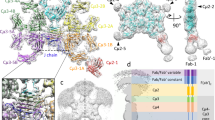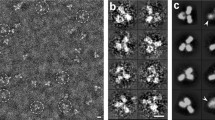Abstract
FVIII is a multi-domain protein organized in a heavy and a light chain, and a B-domain whose biological function is still a matter of debate. The 3D structure of a B-domain-deleted FVIII variant has been determined by X-ray crystallography, leaving unexplained the functional nature of the flexible B-domain which could play an important role in the structure-function relationship since it is removed during the activation process. To obtain clues on the function of the B-domain, the morphology of full-length FVIII and its isolated domains was determined in the absence or presence of Ca2+. Recombinant full-length FVIII, the purified heavy chain, light chain and B-domain as well as B-domain-deleted rFVIII were analysed in buffers of different Ca2+ concentrations by atomic force microscopy. In the absence of Ca2+, FVIII appeared as a globular molecule, whereas at high amounts of Ca2+ up to 50-nm long tail structures emerged. These tails could be identified as unravelled B-domains, as images of isolated B-domains showed the same morphology and heavy chains which include the B-domain were also rich of tails, whereas the isolated light chains and B-domain-deleted FVIII lacked any deviation from a globular shape. The images further suggested that the B-domain interacts with the light chain particularly at low Ca2+ concentrations. Our results show a Ca2+-regulated conformational change of the B-domain in the context of full-length rFVIII. As the B-domain tightly associated with the core of the FVIII molecule under low Ca2+-concentrations, a stabilizing function on FVIII under non-activating conditions may be proposed.



Similar content being viewed by others
References
Lenting PJ, Van Mourik JA, Mertens K (1998) The life cycle of coagulation factor VIII in view of its structure and function. Blood 92(11):3983–3996
Shen B, Spiegel P, Chang C, Huh J, Lee J, Kim J, Kim Y, Stoddard B (2008) The tertiary structure and domain organization of coagulation factor VIII. Blood 111(3):1240–1247
Wakabayashi H, Koszelak ME, Mastri M, Fay PJ (2001) Metal ion-independent association of factor VIII subunits and the roles of calcium and copper ions for cofactor activity and inter-subunit affinity. Biochemistry 40(34):10293–10300
Ngo JCK, Huang M, Roth DA, Furie BC, Furie B (2008) Crystal structure of human factor VIII: implications for the formation of the factor IXa-factor VIIIa complex. Structure 16(4):597–606
Toole JJ, Pittman DD, Orr EC, Murtha P, Wasley LC, Kaufman RJ (1986) A large region (approximately equal to 95 kDa) of human factor VIII is dispensable for in vitro procoagulant activity. Proc Natl Acad Sci U S A 83(16):5939–5942
Fay PJ (1993) Factor VIII structure and function. Thromb Haemost 70:63–67
Pipe SW (2009) Functional roles of the factor VIII B-domain. Haemophilia 15(6):1187–1196
Bovenschen N, Rijken D, Havekes L, Vlijmen B, Mertens K (2005) The B-domain of coagulation factor VIII interacts with the asialoglycoprotein receptor. J Thromb Haemost 3(6):1257–1265
Li X, Gabriel DA (1997) The physical exchange of factor VIII (FVIII) between von Willebrand factor and activated platelets and the effect of the FVIII B-domain on platelet binding. Biochemistry 36(35):10760–10767
Grushin K, Miller J, Dalm D, Parker E, Healey J, Lollar P, Stoilova‐McPhie S (2014) Lack of recombinant factor VIII B‐domain induces phospholipid vesicle aggregation: implications for the immunogenicity of factor VIII. Haemophilia 20(5):723–731. doi:10.1111/hae.12421
Pipe SW (2012) The hope and reality of long‐acting hemophilia products. Am J Hematol 87(S1):S33–S39
Turecek P, Bossard M, Graninger M, Gritsch H, Höllriegl W, Kaliwoda M, Matthiessen P, Mitterer A, Muchitsch E-M, Purtscher M (2012) BAX 855, a PEGylated rFVIII product with prolonged half-life. Haemostasiologie 32:S29–S38
Mosesson MW, Fass DN, Lollar P, DiOrio JP, Parker CG, Knutson GJ, Hainfeld JF, Wall JS (1990) Structural model of porcine factor VIII and factor VIIIa molecules based on scanning transmission electron microscope (STEM) images and STEM mass analysis. J Clin Investig 85(6):1983–1990
Fowler WE, Fay PJ, Arvan DS, Marder VJ (1990) Electron microscopy of human factor V and factor VIII: correlation of morphology with domain structure and localization of factor V activation fragments. Proc Natl Acad Sci U S A 87(19):7648–7652
Bonazza K, Rottensteiner H, Seyfried BK, Schrenk G, Allmaier G, Turecek PL, Friedbacher G (2013) Visualization of a protein-protein interaction at a single-molecule level by atomic force microscopy. Anal Bioanal Chem 406:1411–1421
Mosesson M, Hainfeld J, Wall J, Haschemeyer R (1981) Identification and mass analysis of human fibrinogen molecules and their domains by scanning transmission electron microscopy. J Mol Biol 153(3):695–718
Kempton C, Abshire T, Deveras R, Hoots W, Gill J, Kessler C, Key N, Konkle B, Kuriakose P, MacFarlane D (2012) Pharmacokinetics and safety of OBI‐1, a recombinant B domain‐deleted porcine factor VIII, in subjects with haemophilia A. Haemophilia 18(5):798–804
Larsson L, Ohman S (1978) Serum ionized calcium and corrected total calcium in borderline hyperparathyroidism. Clin Chem 24(11):1962–1965
Conflict of interest
H. Rottensteiner, G. Schrenk, C. Fiedler, F. Scheiflinger and P. L. Turecek are full time employees at Baxter Innovations. K. Bonazza, G. Allmaier and G. Friedbacher declare that they have no conflict of interest.
Author information
Authors and Affiliations
Corresponding author
Electronic supplementary material
Below is the link to the electronic supplementary material.
ESM 1
(PDF 523 kb)
Rights and permissions
About this article
Cite this article
Bonazza, K., Rottensteiner, H., Schrenk, G. et al. Ca2+ concentration-dependent conformational change of FVIII B-domain observed by atomic force microscopy. Anal Bioanal Chem 407, 6051–6056 (2015). https://doi.org/10.1007/s00216-015-8778-z
Received:
Revised:
Accepted:
Published:
Issue Date:
DOI: https://doi.org/10.1007/s00216-015-8778-z




